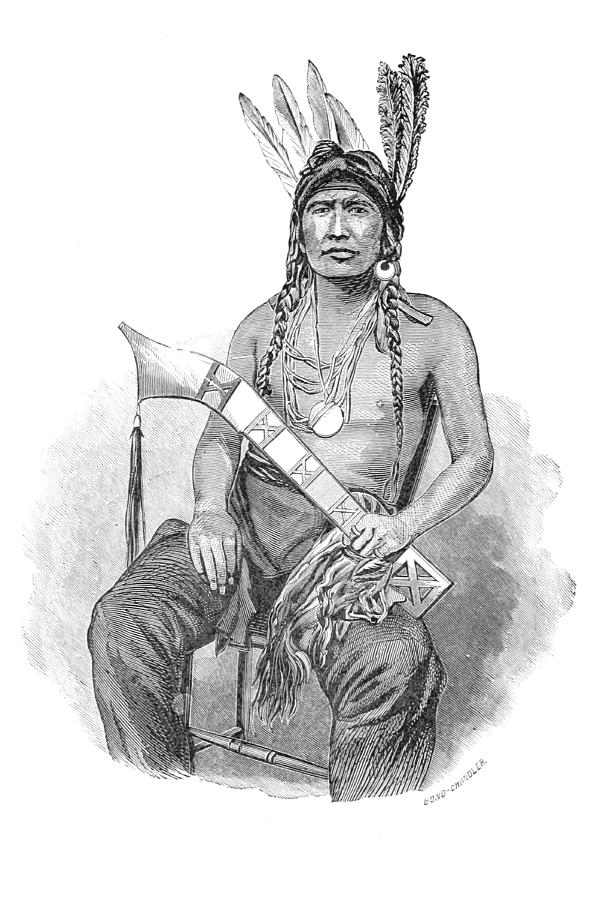William Weatherford
William Weatherford, known as Red Eagle (ca. 1781–March 24, 1824), was a Creek chief of the Upper Creek towns who led many of the Red Sticks actions in the Creek War (1813–1814) against Lower Creek towns and against allied forces of the United States.
One of many mixed-race descendants of Southeast Indians who intermarried with European traders and later colonial settlers, William Weatherford was of mixed Creek, French, and Scots ancestry. He was raised as a Creek in the matrilineal nation and achieved his power in it, through his mother’s prominent Wind Clan (as well as his father’s trading connections. After he showed his skill as a warrior, he was given the “war name” of Hopnicafutsahia, or “Truth Teller.” After the war, he rebuilt his wealth as a slaveholding planter in lower Monroe County, Alabama.
Source: Wikipedia contributors, “William Weatherford,” Wikipedia, The Free Encyclopedia

Red Eagle, William Weatherford, Creek Image taken from page 74 of “The History of Monroe County, Iowa. Illustrated” published by Western Historical Company, 1878. Red Eagle or William Weatherford (1780 or 1781 – March 24, 1824) was a Creek chief. One of many mixed-race descendants of Southeast Indians who intermarried with European traders and later colonial settlers, Red Eagle was of mixed Creek, French and Scots ancestry. He was raised as a Creek in the matrilineal nation and achieved his power in it, through his mother’s prominent Wind Clan, as well as his father’s trading connections. After showing his skill as a warrior, he was given the war name of Hopnicafutsahia. The Creek War (1813-1814), also known as the Red Stick War and the Creek Civil War, was a regional war between opposing Creek factions, European empires, and the United States, taking place largely in Alabama and along the Gulf Coast. The major conflicts of the war took place between state militias and the “Red Stick” Creeks. At the Battle of Horseshoe Bend General Andrew Jackson defeated the Red Sticks, effectively ending the Creek War. Red Eagle and some other 200 Red Sticks escaped, but turned himself in. Jackson spared his life and Red Eagle helped engineer a new peace through a new treaty, which although permanently reducing Creek territory, was lenient in allowing them to retain most of their homes. After the war, he rebuilt his wealth as a slaveholding planter in lower Monroe County, Alabama where he died in 1824.
In 1813, Red Eagle, William Weatherford’s Indian name was Hoponika Futsahia, joined the Red Sticks’ fight against the whites who were moving into their territory. Red Eagle and Peter McQueen, his cousin by marriage, planned an attack on Ft. Mims. It is said that Weatherford tried to stop the attack for he learned some of his family were there.
Nearby, the Creeks — the Red Sticks– are mightily armed and preparing for war! They number over 1000. Their leaders are William Weatherford — Red Eagle, Peter McQueen, and Josiah Francis. William Weatherford is surely torn for within the fort are his brothers and sister and their families. But there in the fort, also, are enemies and one, William’s bitterest enemy, Dixon Bailey.
William Weatherford, known as Red Eagle (ca. 1781–March 24, 1824), was a Creek chief of the Upper Creek towns who led many of the Red Sticks actions in the Creek War (1813–1814) against Lower Creek towns and against allied forces of the United States.
One of many mixed-race descendants of Southeast Indians who intermarried with European traders and later colonial settlers, William Weatherford was of mixed Creek, French, and Scots ancestry. He was raised as a Creek in the matrilineal nation and achieved his power in it, through his mother’s prominent Wind Clan (as well as his father’s trading connections[not verified in body]). After the war, he rebuilt his wealth as a slaveholding planter in lower Monroe County, Alabama.
Wikipedia contributors, “William Weatherford,” Wikipedia, The Free Encyclopedia,
A very interesting and informative artice about Red Eagle & American History